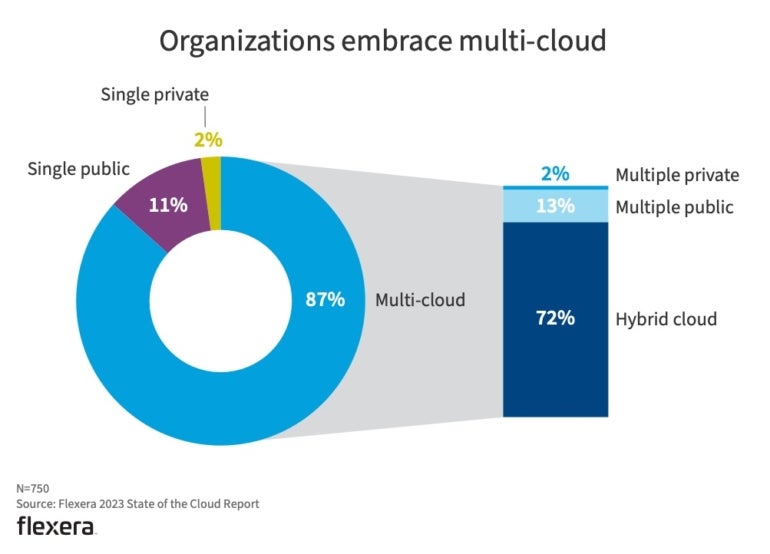
The private cloud, as we know it, first came onto the scene in 2010 when companies like Microsoft, AWS and OpenStack developed private clouds that were reasonably functional. This is also when OpenStack created an open-source, do-it-yourself and free cloud.
In this article, we define private cloud and explain how it works, noting the benefits and disadvantages. We provide you with a comprehensive understanding of private cloud, enabling you to make informed decisions about its relevance and applicability to your organization.
Jump to:
A private cloud is a single-tenant environment, meaning only one organization uses the infrastructure and directly controls it. It’s one of three main cloud deployment models — private, public and hybrid. There is also multicloud, which combines elements of all three.
SEE: Explore the benefits and drawbacks of a hybrid cloud setup.
A private cloud can be hosted and managed in various ways, including utilizing resources and infrastructure that are already on-premises, utilizing separate infrastructure provided by a third-party organization or being enabled solely using virtualization software.
A private cloud dedicates specific cloud resources to a single organization or tenant, ensuring a high level of security and privacy through a proprietary architecture. Either the organization itself or a third-party service manages this architecture.
The organization’s intranet or a hosted data center houses the private cloud infrastructure, where a private network maintains services and infrastructure. This setup provides the organization with greater control over data, improved security, and the flexibility to customize hardware and software to meet specific business needs.
In addition, firewall technology protects the data stored in a private cloud, and internal hosting ensures the organization retains control over sensitive information.
Private clouds differ in hosting and management and provide varying capabilities depending on the organization’s needs. There are four main types of private clouds:
However, the above only categorizes private cloud in terms of hosting and management. Other classifications consider the cloud infrastructure used:
Private clouds offer a host of benefits when compared to public cloud solutions.
Perhaps most importantly, private clouds deliver higher levels of customization and control. This is because private cloud environments aren’t shared with other organizations in the way public clouds are. As a result, private cloud users can configure their applications and systems to meet their specific needs and requirements.
SEE: TechRepublic Premium’s cloud engineer hiring kit has everything you need to find the right person for your engineering team.
In addition, private cloud solutions offer better security and compliance with certain regulations. For organizations that handle sensitive data, private clouds can provide an extra layer of protection.
A private cloud can be configured to meet these regulations, providing an audit trail for compliance purposes. This is often more challenging in a multicloud or hybrid cloud setup, where data may be stored in different locations and subject to different jurisdictions.
Private clouds are often deployed when public clouds are deemed inappropriate or inadequate. For example, mission-critical workloads exceeding risk tolerance levels may be better suited for private clouds.
Private clouds are becoming increasingly popular as businesses look for ways to improve efficiency and control costs. However, private clouds come with a number of disadvantages, which have led to a gradual shift to multicloud setups.
Private clouds require a significant investment in hardware and software and careful planning and management. In addition, the increased complexity could mean that companies without experienced cloud engineers can face the same problem that public cloud customers encounter with poor configuration, provisioning and overburdened servers.
Private clouds can be less scalable than public clouds, making them less able to deal with spikes in demand. Scalability requires significant investment in additional hardware and software in private cloud setup. This can be time-consuming and costly.
Private clouds can also be more inflexible, meaning organizations using a private cloud won’t be able to quickly adapt to changes in technology, business needs or market conditions. Moreover, changes to private cloud infrastructure can be complex and require significant investment, especially where new technology is incompatible with existing infrastructure.
One of the main drawbacks of private clouds is the initial investment required for acquisition, deployment and support. For example, a company will need to purchase expensive hardware and software as well as hire staff with the necessary expertise to maintain and support the system.
Further, subscription costs of hosted private cloud can sometimes exceed the cost of total ownership.
Several factors determine the cost of private cloud:
As regards pricing models, private cloud costs are typically structured in one of two ways:
When configured correctly, private cloud offers much better security since it dedicates its entire infrastructure to a single organization, unlike multicloud or hybrid cloud setups, where resources are shared among multiple tenants. Therefore, with a private cloud setup, the organization has complete control over its data, reducing the risk of unauthorized access or data breaches.
In a private cloud environment, the organization can implement stringent security policies and controls tailored to its specific needs. This includes:
Private clouds also offer better visibility and control over the entire infrastructure. In a multicloud or hybrid cloud setup, parts of the infrastructure are managed by different providers, which can make it difficult to monitor and manage security effectively. In contrast, a private cloud provides a unified view of the entire infrastructure, making it easier to detect and respond to potential security threats.
Some major private cloud providers include Amazon Web Services, Microsoft Azure, Google Cloud, IBM Cloud and VMware. Each vendor offers a range of private cloud options with varying levels of customization and control.
Based on the advantages that private cloud offers, it would seem like an obvious choice. There is only one problem: cost. The cost of private cloud on both a CapEx or OpEx model can be prohibitively high for most organizations, leading them to implement hybrid, public or multicloud setups instead.
According to Flexera’s 2023 State of the Cloud report, only 2% of 750 IT professionals surveyed use a single private cloud, with multicloud deployments being the de facto standard (Figure A).
Figure A

The Flexera report also emphasizes that managing cloud spend has overtaken security as the top challenge facing organizations. This indicates that while cost is a concern, the ability to effectively manage and optimize that spend is equally important.
A multicloud strategy allows organizations to leverage the strengths of different cloud providers and avoid vendor lock-in. This approach can provide cost savings, flexibility and resilience. However, it also requires careful management to ensure that resources are used efficiently, and that security is maintained across different platforms.
Given these considerations, it’s clear that the decision to use a private cloud shouldn’t be based solely on cost. Instead, organizations should consider their specific needs, including their security requirements, regulatory environment and the nature of their workloads. For mission-critical applications and sensitive data, a private cloud may be the best option, despite the higher cost.